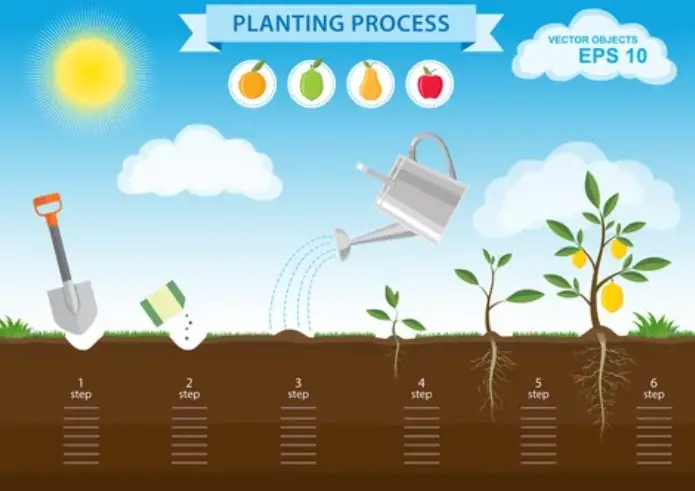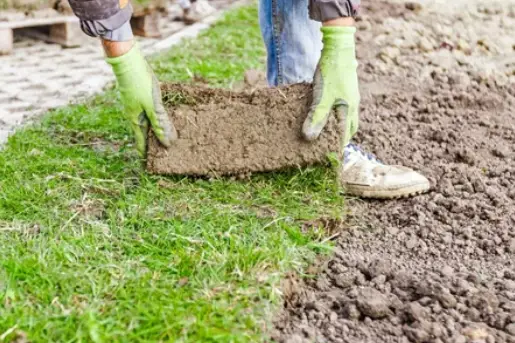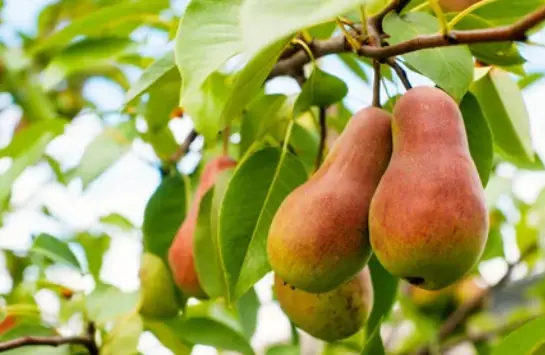If you are one of the people who love pears and want to grow your own. Well, you are at the right place.
Pears are a delicious and nutritious fruit that can be enjoyed fresh, cooked, or preserved.
However, pear trees take more than just planning them like a regular fruit tree. They require a little more attention and care.
So, if you have the space in your yard, consider planting a pear tree to enjoy these tasty treats for years to come.
Here’s how to do it:

1) Choose the Right Location for Your Pear Tree
Pear trees need full sun and well-draining soil to thrive, so it’s important to choose a location that meets these requirements.
It’s best to avoid planting in a low-lying area where frost may settle, as pears are prone to frost damage.
Look for a spot in your yard that gets at least six hours of direct sunlight per day.
Pear trees also need good air circulation to prevent disease, so avoid planting them in a spot that is crowded by other trees or structures.
Also, the soil in the chosen location should be well-draining, as pears don’t tolerate standing water.
To test the drainage of your soil, dig a hole about a foot deep and fill it with water.
Remember, If the water drains away within a few hours, the soil is well-draining.
If it takes longer, you may need to improve the drainage by adding sand or organic matter to the soil.
2) Choose the Right Variety of Pear Tree

There are many different varieties of pear trees to choose from, each with its own unique characteristics. When selecting a variety, consider the following factors:
Size:
Pear trees come in both dwarf and standard sizes. Dwarf trees are smaller and more compact, making them a good choice for small yards or gardens. Standard trees are larger and can reach heights of up to 30 feet.
Hardiness zone:
Pear trees are generally hardy in zones 4-9. Be sure to choose a variety that is suitable for your region’s climate.
Ripening time:
Pears can be divided into two categories based on their ripening time: early season and late season.
Early-season pears ripen in late summer or early fall, while late-season pears ripen in the fall or early winter.
Flavor and texture:
There are many different varieties of pears to choose from, each with its own unique flavor and texture.
Some popular varieties people love to grow are Bartlett, Anjou, Bosc, and Comice. Consider your personal preferences when selecting a variety.
Pollination:
Some pear trees are self-fertile, which means they don’t need another pear tree nearby to produce fruit.
Others are not self-fertile and will need to be planted near another compatible pear tree in order to produce fruit.
Be sure to check the pollination requirements of the variety you are considering.
3) Purchase a Healthy Pear Tree from a Reputable Nursery or Supplier
When purchasing a pear tree, it’s important to choose a healthy tree from a reputable nursery or supplier.
Look for a tree with a strong, straight trunk and well-developed root system.
Avoid trees with damaged or diseased roots or branches.
Here are a few tips for selecting a healthy pear tree:
Inspect the Tree:
Look for a tree with a strong, straight trunk and well-developed branches. Avoid trees with cracks, wounds, or other damage to the trunk or branches.
Check the Root System:
The root system should be well-developed and free of damage or disease. Avoid trees with roots that are circling the root ball or appear to be suffocating each other.
Consider the Tree’s Size:
Choose a tree that is the right size for your yard. A dwarf tree is a good choice for a small yard, while a standard tree is better suited for a larger space.
Check the Tree’s Age:
Younger trees are generally more adaptable and easier to care for than older trees. Look for a tree that is 2-3 years old.
By following these tips, you can choose a healthy pear tree that will thrive in your yard.
4) Prepare The Planting Site

Before planting your pear tree, it’s important to prepare the site to ensure that your tree has the best possible conditions for growth. Here’s how to do it:
Loosen the Soil:
If the soil in your chosen location is heavy or compacted, use a garden fork to turn it over and loosen it up. This will help the tree’s roots to establish more easily.
Add Compost or Well-Rotted Manure:
Adding compost or well-rotted manure to the soil will improve its structure and fertility, providing your tree with the nutrients it needs to grow.
Test the Soil pH:
Pears prefer a soil pH of 6.0-7.0. If your soil is too acidic or alkaline, your tree may struggle to grow. You can test the soil pH with a soil test kit from a gardening store or online.
Choose the Right Planting Time:
The best time to plant a pear tree is in the fall or early spring when the tree is dormant. This allows the tree to focus on root growth rather than leaf production.
5) Plant Your Pear Tree
Now that you’ve prepared the planting site, it’s time to plant your pear tree. Here’s how to do it:
Dig a Hole:
Dig a hole that is slightly larger than the root ball of your tree. The hole should be deep enough to accommodate the roots, but not so deep that the tree will be planted too deeply.
Remove the Tree From its Container:
Gently remove the tree from its container, taking care not to damage the roots. If the roots are tightly bound, use a sharp knife to carefully cut through the roots to loosen them.
Place the Tree in The Hole:
Place the tree in the hole and position it so that the trunk is straight and the roots are evenly distributed.
Fill in The Hole With Soil:
Fill in the hole with soil, making sure to cover the roots completely. Tamp down the soil gently to remove any air pockets.
Water The Tree Well:
Water the tree thoroughly to help the soil settle around the roots. If the soil is dry, you may need to water the tree more than once.
6) Prune your pear tree:
Pruning is an important part of caring for a pear tree. It helps to encourage healthy growth, remove damaged or diseased branches, and shape the tree. Here’s how to prune your pear tree:
Start by removing any damaged or diseased branches:
Look for branches that are diseased, damaged, or dead and remove them using a pair of sharp pruning shears. Make the cut just above a healthy bud or branch.
Cut back any branches that are crossing or rubbing against each other:
These branches can damage each other over time and should be removed to prevent further damage.
Cut back any branches that are growing vertically:
Pears tend to grow vertically, but it’s important to encourage lateral growth as well. To do this, cut back the vertically growing branches to encourage the growth of lateral branches.
Prune in the winter:
The best time to prune a pear tree is in the winter, when the tree is dormant. This allows the tree to focus on root growth rather than leaf production.
7) Water Your Pear Tree Regularly
Watering is an important part of caring for a pear tree.
Pears need plenty of water, especially during dry spells, to stay healthy and produce fruit. Here’s how to water your pear tree:
Check the soil moisture:
Before watering your pear tree, check the moisture level of the soil. If the top few inches of soil are dry, it’s time to water the tree.
Water deeply:
When watering your pear tree, be sure to water deeply to reach the root zone. This will help encourage deep root growth and drought tolerance.
Avoid getting water on the foliage:
Watering the foliage of a pear tree can encourage disease, so be sure to avoid getting water on the leaves.
Water regularly:
Aim to water your pear tree once a week, or more frequently if the soil is dry.
8) Fertilize your pear tree
Fertilizing is an important part of caring for a pear tree. Pears benefit from regular fertilization to promote healthy growth and fruit production. Here’s how to fertilize your pear tree:
Choose the right fertilizer:
Use a balanced fertilizer that is formulated for fruit trees. Look for a fertilizer with a ratio of equal parts nitrogen, phosphorous, and potassium, such as a 10-10-10 or 20-20-20 formula.
Follow the instructions on the label:
Fertilizer labels will provide specific instructions for how much and how often to fertilize your pear tree. Be sure to follow these instructions carefully to avoid over-fertilizing, which can lead to excessive foliage growth at the expense of fruit production.
Apply the fertilizer in the spring:
The best time to fertilize a pear tree is in the spring when the tree is starting to grow. Avoid fertilizing in the fall, as this can encourage new growth that may not have time to harden off before winter.
Use organic fertilizers:
If you prefer to use organic fertilizers, options such as compost, well-rotted manure, or bone meal can be effective. Follow the instructions on the label for application rates.
9) Protect your pear tree from pests and diseases
Pests and diseases can be a problem for pear trees, but there are steps you can take to protect your tree. Here are a few tips:
Keep an eye out for pests:
Pears are prone to a number of pests, including pear scabs, fire blight, and codling moths. Keep an eye out for any signs of these problems, such as damaged foliage or fruit, and take appropriate action.
Use pesticides as needed:
If you do notice pests on your pear tree, you may need to use pesticides to control the problem. Be sure to use pesticides according to the label instructions and choose products that are specifically formulated for use on fruit trees.
Practice good cultural practices:
There are a number of cultural practices that can help prevent pests and diseases from becoming a problem for your pear tree.
These include removing and destroying infected branches, keeping the tree well-watered and fertilized, and maintaining good air circulation around the tree.
10) Enjoy the fruit of your labor
After you’ve planted and cared for your pear tree, it’s time to sit back and enjoy the fruit of your labor.
It will take a few years for your pear tree to start producing fruit, but once it does, you’ll be able to enjoy delicious, homegrown pears for years to come.
Here are a few tips for enjoying your homegrown pears:
Harvest at the right time:
Pears are ripe when they are slightly soft to the touch and fragrant. To check for ripeness, gently press on the stem end of the pear. If it gives slightly, it’s ready to be picked.
Store pears properly:
Pears will continue to ripen after they are picked, so it’s important to store them properly. Keep pears at room temperature until they are fully ripe, then move them to the refrigerator to slow down the ripening process.
Enjoy fresh or cooked:
Pears can be enjoyed fresh or cooked in a variety of dishes. They are deliciously sliced and served with cheese, baked into pies or tarts, or poached and served with ice cream.
Final Thoughts
Planting and caring for a pear tree can be a rewarding and enjoyable project that provides you with a bounty of delicious fruit for years to come.
By following the steps outlined in this blog post, you can successfully plant and care for a pear tree in your yard.
First, choose the right location for your pear tree, taking into account factors such as sunlight and soil type.
Next, select the right variety of pear trees for your climate and personal preferences.
Purchase a healthy pear tree from a reputable nursery or supplier, and prepare the planting site by loosening the soil and adding compost or well-rotted manure.
Plant your pear tree according to the steps outlined in this blog post, and be sure to water, fertilize, and protect your tree from pests and diseases as needed.
With proper care, your pear tree will thrive and produce delicious fruit for you to enjoy. So why wait? Get started on planting your own pear tree today and enjoy the sweet rewards of your labor for years to come.




